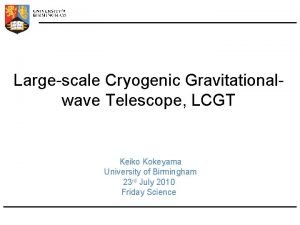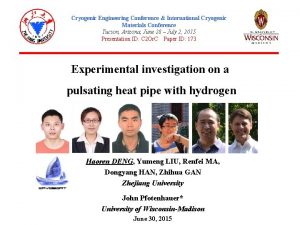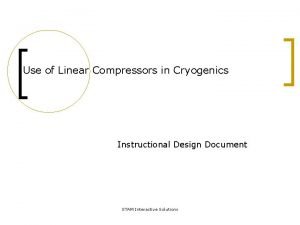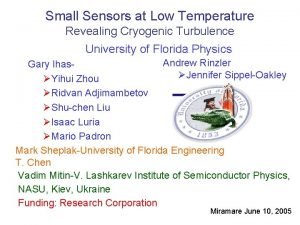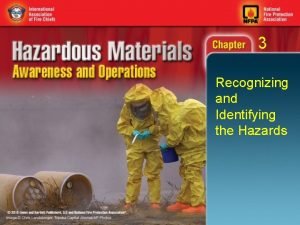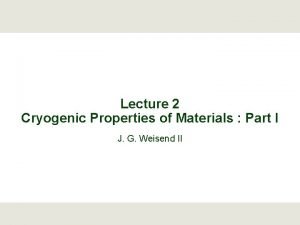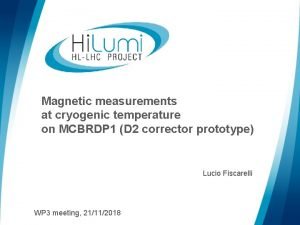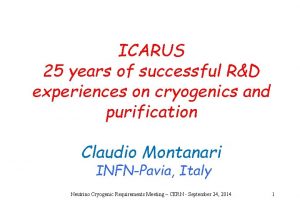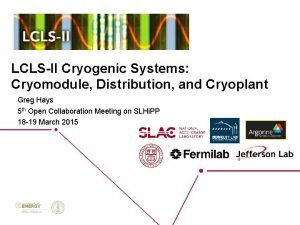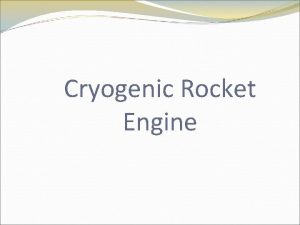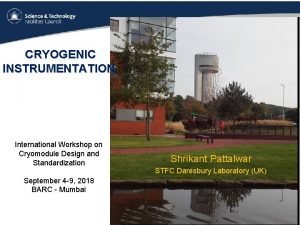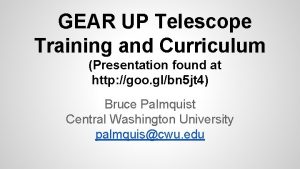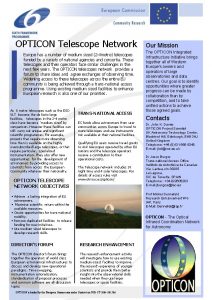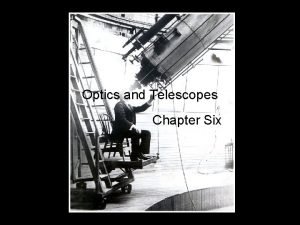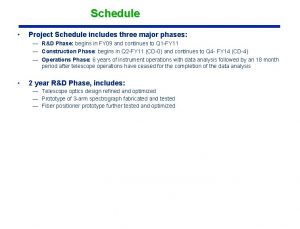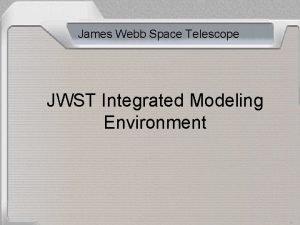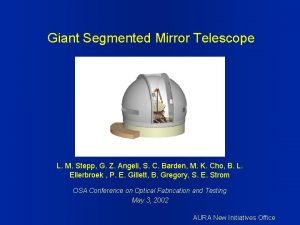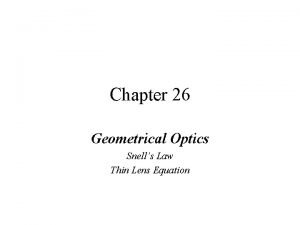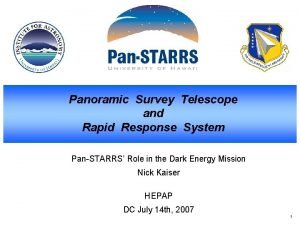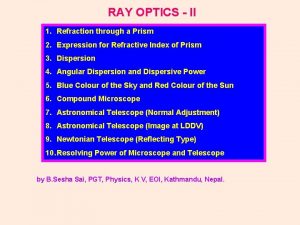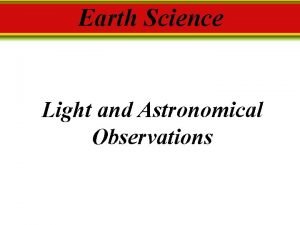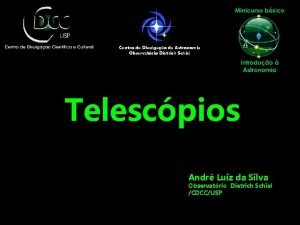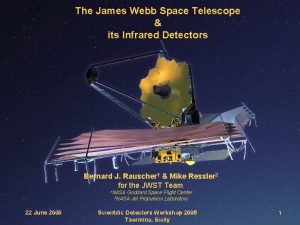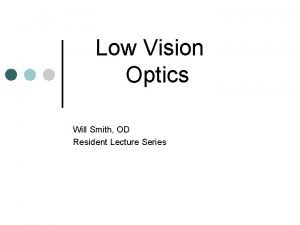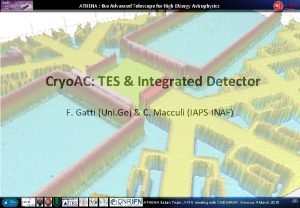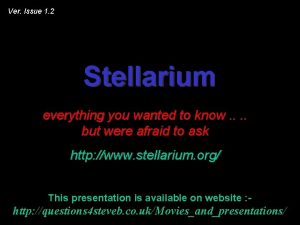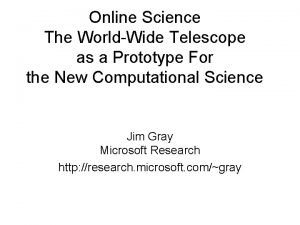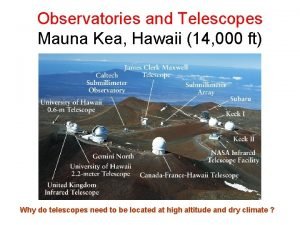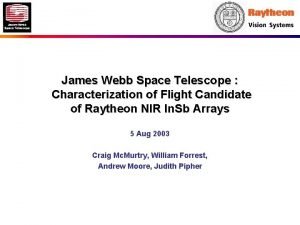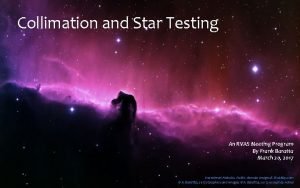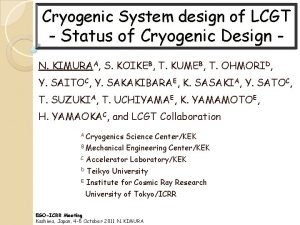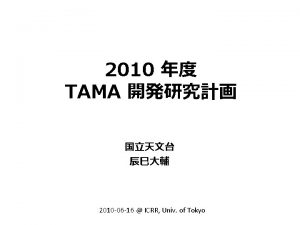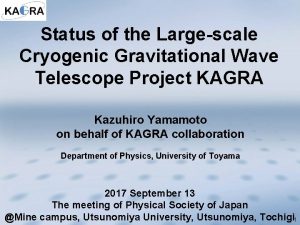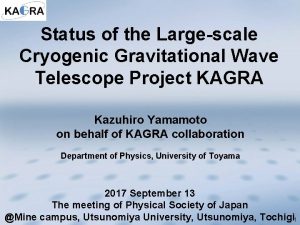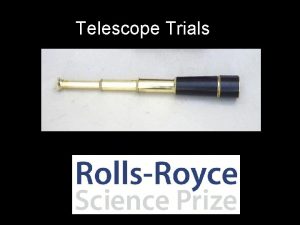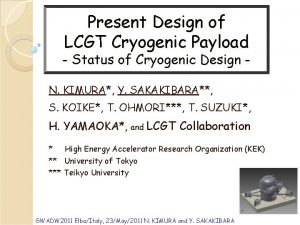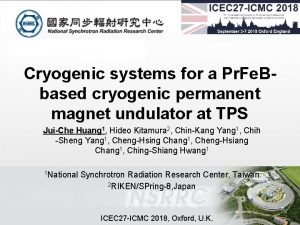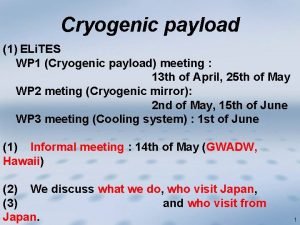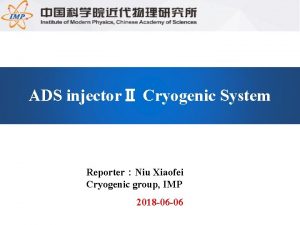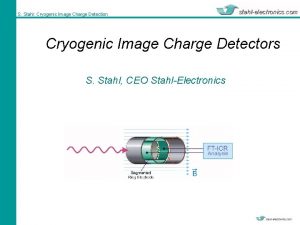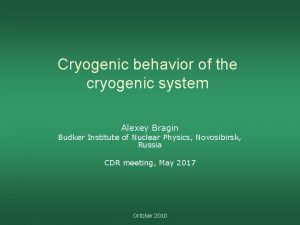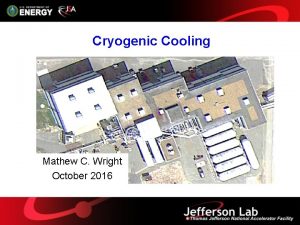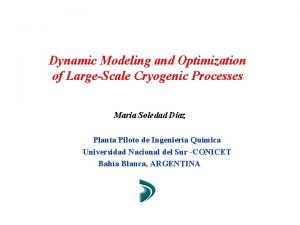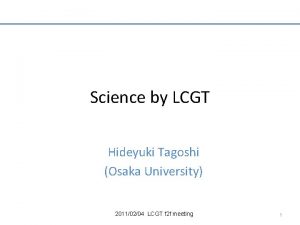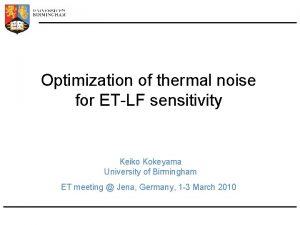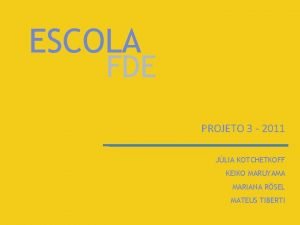Largescale Cryogenic Gravitationalwave Telescope LCGT Keiko Kokeyama University




































- Slides: 36

Large-scale Cryogenic Gravitationalwave Telescope, LCGT Keiko Kokeyama University of Birmingham 23 rd July 2010 Friday Science

Contents General introduction of LCGT project Introduction of gravitational waves (GWs) Introduction of LCGT Science goal and impact Technical features Underground, Seismic isolation system, Cryogenic, Optical configuration, Operation modes Technical background CLIO project as a LCGT prototype Photos and plots are from “LCGT design document, “ CLIO/LCGT talks by Miyoki-san and Yamamoto-san, and “Study report on LCGT interferometer observation band” Keiko Kokeyama 23 July 2010 @ Friday Science 0/28

Gravitational Waves Ripples of spacetime propagating at the speed of light. Changing the distances between free particles. Coalescences of y x neutron star binaries, Supernova, BH coalescences, etc. Einstein predicted its existence as a consequence of the general relativity in 1916. Its existence is verified indirectly by the binary-neutron star observation, however, the direct detection has not been successful yet. Significances of the direct detection Experimental verification of the general relativity The GW astronomy Keiko Kokeyama 23 July 2010 @ Friday Science 1/28

Gravitational Wave Detectors Mirror Laser interferometer (ifo) type GW changes the mirror positions The path length difference is detected as the phase difference between the two paths GW has a very weak interaction to matters - very small path length change Mirror Beamsplitter Bright Laser Dark Photo detector Super accurate measurement to detect 10 -20 m change per 1 m Keiko Kokeyama 23 July 2010 @ Friday Science 2/28

Large Scale ground-based GW detectors The 1 st Generation Detectors GEO 600 VIRGO LIGO TAMA 300 Upgrading to the 2 nd Generation Detectors Advanced LIGO, Advanced VIRGO, GEO HF, LCGT Keiko Kokeyama 23 July 2010 @ Friday Science 3/28

LCGT project On 22 nd June, the Japanese Next Generation Detector, LCGT was funded 9. 8 billion yen (£ 75 M) for three years including 2010. selected one of the projects for the forefrontresearch-development-strategic subsidy (40 billion yen in total) of Ministry of education, culture, sports, science and technology, Japan The purpose of this subsidy is to develop the environment for the young or female scientists, and internationally high level researches Further budget is being requested to run the project after the 3 rd year. The result will be appear in August. Keiko Kokeyama 23 July 2010 @ Friday Science 4/28

Scientific Goals Establish the GW astronomy Main goal: to detect gravitational waves from neutron star binaries (1. 4 solar mass) at about 200 Mpc with > S/N 8 Expecting a few events in a year from: Coalescences of neutron star binaries Goal sensitivity: h=3 × 10 -24 [m/rt. Hz] at 100 Hz Keiko Kokeyama 23 July 2010 @ Friday Science 5/28

GW detector network LCGT plays a role of Asia-Oceania center among other detectors Best sensitivity direction for LCGT LIGO Hanford LIGO Livingston VIRGO The good-sensitivity directions are complementary for other detectors Keiko Kokeyama 23 July 2010 @ Friday Science 6/28

Technical Features of LCGT (1) Underground Site (2) Seismic isolation system (3) Cryogenic Technique Thermal noise design, Substrate of test mass (4) Optical configuration Four configurations and the observation plan Keiko Kokeyama 23 July 2010 @ Friday Science 7/28

(1) Underground Site Keiko Kokeyama 23 July 2010 @ Friday Science 8/28

(1) Underground Site Keiko Kokeyama 23 July 2010 @ Friday Science 9/28

(1) Underground Site Keiko Kokeyama 23 July 2010 @ Friday Science 10/28

(1) Underground Site More than 2 orders of magnitude better than TAMA site The variance of 46 hours is about 0. 1~0. 2 degrees without temperature-controlling Keiko Kokeyama 23 July 2010 @ Friday Science 11/28

(2) Seismic isolation system n Requirement: -190 d. B at 3 Hz including the suspension part (*) and seismic isolation system n Seismic level in Kamioka is 10 -9 m/rt. Hz at 3 Hz n Sensitivity requirement is 3 x 10 -18 m/rt. Hz at 3 Hz n The seismic isolation system (room temperature) is required -130 d. B isolation (*) Test masses are suspended so that they act as free masses. Suspensions play a role of isolating the seismic motion, too. Keiko Kokeyama 23 July 2010 @ Friday Science 12/28

(2) Seismic isolation system n Inverted pendulum n Three GAS (Geometric antispring) filters This system achieves isolation ratios of: n-160 d. B for horizontal (w/ 4 stages) at 3 Hz n-140 d. B for vertical (w/ 3 stages) at 3 Hz These satisfy the requirement ↓ 2 -stage suspension (Low temperature) Keiko Kokeyama 23 July 2010 @ Friday Science 13/28

(3) Cryogenic We want to reduce thermal noise Thermal noise is… To reduce thermal noise, the main mirrors and suspension are cooled down to 20 K by refrigerators sapphire f 250 × 150 mm, 30 kg Keiko Kokeyama 23 July 2010 @ Friday Science 14/28

(3) Cryogenic Heat links are used to release the heat occurred by the laser beam on the test-masses SAS, 300 K Heat link 1 W, 7 × f 1 mm, Al Heat link 1 W, 5 × f 3 mm Al Recoil Masses will be suspended by Sapphire or Al wires Bolfur wire 40 cm, f 1. 8 mm 10 K 20 K Sapphire wire, 860 m. W 40 cm, f 1. 8 mm 8 K, 100 K Similar type to CLIO refrigerator (Sumitomo Heavy Industries Ltd, Pulse-tube refrigerator) Keiko Kokeyama 23 July 2010 @ Friday Science 15/28

(4) Optical configuration Main IFO Keiko Kokeyama 23 July 2010 @ Friday Science 16/28

(4) Optical configuration Main IFO Resonant-Sideband-Extraction (RSE) FP cavity In addition to the Fabry-Perot (FP) arm cavities, Power recycling and signal extraction cavities (PRC and SEC, respectively) are added to the interferometer FP cavity Advantages in capability of high laser power in arm cavities and flexibility in observation band Keiko Kokeyama 23 July 2010 @ Friday Science PRC SEC 17/28

(4) Optical configuration Operation modes BRSE: Broad band operation The carrier laser light is anti-resonant in SEC. Detector observation band is tuned to have a maximum sensitivity for neutron-star inspiral events. DRSE: Detuned RSE. Detuning is a technique to increase detector sensitivity only in a slightly narrow frequency band. It is realized by controlling the SEC length between resonance and anti-resonance condition for the carrier laser beam. V-BRSE: Broad band operation + slightly off resonance in the arm cavity V-DRSE: Detuned operation+ slightly off resonance in the arm cavity FP PRC FP SEC Keiko Kokeyama 23 July 2010 @ Friday Science 18/28

(4) Optical configuration Operation modes DRSE configuration has the best floor-level sensitivity at BRSE configuration has wider band. It around 100 Hz, and the good observable distance for neutronstar inspiral events. Therefore the detuned configurations have advantages in the first detection and expected number of events. can provides longer observation duration for an inspiral event. It is good for extracting information from observed waveforms, in accuracy of estimated binary parameters, the arrival time, and so on. V-BRSE and V-DRSE have both advantages. Keiko Kokeyama 23 July 2010 @ Friday Science 19/28

(4) Optical configuration Operation Strategy Operate in the V-DRSE mode first for earlier detection of gravitational-wave signals After the first few detections, they will switch to the VBRSE mode. Keiko Kokeyama 23 July 2010 @ Friday Science 20/28

Technical Background Suspended 4 m RSE Keiko Kokeyama 23 July 2010 @ Friday Science 21/28

CLIO n In Kamioka mine n Prototype ifo for LCGT n To demonstrate thermal noise reduction using cryogenic technique n 100 m base-line unrecombined Fabry-Perot Michelson interferometer Beam-splitter Fabry-Perot cavity Keiko Kokeyama 23 July 2010 @ Friday Science 22/28

Design sensitivity of CLIO Keiko Kokeyama 23 July 2010 @ Friday Science 23/28

Cryogenic in CLIO 2008: 300 K design sensitivity achieved. 300 K mirror thermal noise dominates the sensitivity around 150 Hz. 2009: Both near mirrors were cooled at about 20 K. The suspended sapphire mirror (f 100× 60, 2 kg) 2010: Sensitivity around 150 Hz were improved. 6 -stage vibration isolation (3 stages in 300 K, 3 stages in cryogenic) Total mirror thermal noise were reduced. Low vibration refrigerator Keiko Kokeyama 23 July 2010 @ Friday Science 24/28

Displacement in November 2008 n Almost thermal noise limited at 300 K (4/2008 to 12/2008) n Clio displacement touched the predicted thermal noise level Sapphire mirror themal noise Suspension thermal noise (20 -80 Hz) Keiko Kokeyama 23 July 2010 @ Friday Science 25/28

Reduction of Mirror Thermo-Elastic Noise Two near mirrors are cooled down to 20 K It took 250 hours for cooling the mirror. The near mirrors were cooled at 16. 4 k and inner shield was cooled at 11. 5 k. The outer shield of the mirror tank and center of the cryogenic vacuum pipe were cooled at 69 k and 49 k, respectively. Keiko Kokeyama 23 July 2010 @ Friday Science 26/28

Reduction of Mirror Thermo-Elastic Noise CLIO has finally demonstrated the reduction of thermal noise on sapphire mirrors around 200 Hz Keiko Kokeyama 23 July 2010 @ Friday Science 27/28

Summary LCGT Just funded! The overview of LCGT project such as underground site, Seismic isolation system, cryogenic, optical configuration were reviewed. CLIO As the prototype for LCGT, CLIO successfully demonstrated thermal noise reduction. Cryogenic, underground techniques are established for LCGT Note: Some parameters and materials are still under discussion toward the final design Keiko Kokeyama 23 July 2010 @ Friday Science 28/28

End

Supplement slide (1) Wave length 1064 1546 Initial Laser Power Arm cavity Finesse 150 Arm power gain 9984 = 960 x 10. 4 Arm power (single arm)2 420. 5 == 374. 4 = 75 *9984 /2 k. W 78. 48 (in Injecting Laser total), 75 Power into IFO (carrier) Modulation depth 0. 3 for both RF freq 1 11. 25 M (PM) RF freq 2 45. 00 M (AM) MC 1 length 10. 0 MC 2 length 13. 324109 MC 1 Finesse TBD MC 2 Finesse TBD Arm cavity cut -off frequency PR gain 10. 4 PRC power on 780 = 75 * BS 10. 4 W PR cavity cutoff frequency PR-Arm cutoff frequency SR gain 11 (not checked yet) Arm cavity length 3006. 69 m PR cavity length 73. 2826 m Asymmetry length 3. 33103 m BS-FM length 25 m SR cavity length 73. 2826 m SRC detuning phase 86. 5 3. 4 ? ? ?

Supplement slide (2) EM mass 30 FM mass 30 PRM mass TBD SRM mass TBD BS mass EM Reflectivity 0. 999945 FM Reflectivity 0. 996 TBD PRM Reflectivity 0. 9 EM ROC 7113. 900 m SRM Reflectivity 0. 8464 = 0. 922 FM ROC 7113. 900 m FM AR ROC TBD BS Reflectivity 0. 5 PRM ROC TBD SRM ROC TBD BS ROC Infinity HR Coating Loss of EM, 45 e-6 FM, PRM and SRM BS Loss EM radius/thickn ess FM radius/thickn ess PRM radius/thickn ess SRM radius/thickn ess BS radius/thickn ess 100 e-6 25 / 15 cm Transmissivit y 0. 999 25 / 15 cm AR Transmissivit y AR Coating Loss 1000 e-6 1 - R - Loss TBD Bulk loss (absorption) (large optics ? ? ? for Sapphire: ? ? ? FM, EM) OMC length 1. 5 m Beam radius 3 cm Young's modulus 4 e 11 of Sapphire Pa OMC Finesse 2000 Suspension length 40 cm Density of Sapphire 4 e 3 kg/m^3 Poisson ratio of Sapphire 0. 29 Thermal expansion of Sapphire (20 K) 5. 6 e-9 1/K Specific heat of Sapphire (20 K) 0. 69 J/K/kg Thermal conductivity of Sapphire (20 K) 1. 57 e 4 W/m/K Thermal expansion of Sapphire (300 K) 5. 0 e-6 1/K OMC input/output TBD mirror reflectivity Diameter of suspension fiber 1. 8 mm 4 OMC end mirror reflectivity Number of suspension fiber TBD Temperature of suspension OMC MC FSR ? ? ? DC readout phase Mechanical loss of 2 e-7 fiber 134. 7 deg Control Bandwidth Quantum efficiency 0. 9 CARM control 30 k Hz band width DARM 200 Hz control band width PRC control band width 50 Hz MICH control 50 Hz band width 20 ppm Bulk loss (absorption) (small optics 2. 5 ? ? ? for Fused Silica: ? ? ? ) 121. 8 d eg SRC control band width 50 Hz -0. 97 (openloop), Feed-Forward 1/(1 -0. 97) = gain 30 (closed loop) 16 K Mirror radius 12. 5 cm Specific heat of Sapphire (300 K) 790 J/K/kg Mirror thickness 15 cm Bulk absorption 20 ppm/cm Thermal conductivity of Sapphire (300 K) 40 W/m/K Coating absorption 0. 1 ppm Young's modulus 7. 2 e 10 of Silica Pa Poisson ratio of Silica 0. 17 Refraction index of Silica 1. 45 Mechanical loss of 1 e-8 a mirror Thermal expansion of Silica (300 K) 5. 1 e-7 1/K Number of coating 9 layers (ITM) Specific heat per volume of Silica (300 K) 1. 64 e 6 J/K/m^3 Thermal conductivity of Silica (300 K) 1. 38 W/m/K dn/d. T of Silica (300 K) 8 e-6 1/K Temperature of mirrors 20 K Number of coating 18 layers (ETM) Mechanical loss of 1 e-4 Silica coatings Mechanical loss of 4 e-4 Tantala coatings Optical loss of each 70 ppm/roundtrip arm Optical loss in the SRC Optical loss at the PD Young's modulus 1. 4 e 11 of Tantala Poisson ratio of Tantala 0. 23 Refraction index of Tantala 2. 06 Thermal expansion of Tantala (300 K) 3. 6 e-7 Pa 1/K 2% Specific heat per volume of Tantala 2. 1 e 6 (300 K) J/K/m^3 10% Thermal conductivity of Tantala (300 K) 33 W/m/K dn/d. T of Tantala (300 K) 14 e-6 1/K

Suppliment slide (3)

Suppliment slide (3) Reduction of Suspension Thermal Noise

Vacuum tanks Vacuum level n 2 x 10 -7 Pa Vacuum duct 3 km length n 1 m diameter n steinless steel n
 Keiko kokeyama
Keiko kokeyama International cryogenic materials conference
International cryogenic materials conference Independence cryogenic engineering
Independence cryogenic engineering Cryogenic temperature
Cryogenic temperature Complete cryogenic services
Complete cryogenic services Mc 338
Mc 338 Cryogenic materials data handbook
Cryogenic materials data handbook Cryogenic temperature
Cryogenic temperature Cryogenic research icarus
Cryogenic research icarus Cryogenic transferlines
Cryogenic transferlines Cold stretching cryogenic vessel
Cold stretching cryogenic vessel Cryogenic rocket meaning
Cryogenic rocket meaning Cryogenic instrumentation
Cryogenic instrumentation Naap astronomy
Naap astronomy Opticon telescope
Opticon telescope Land based telescope
Land based telescope Telescope how to use
Telescope how to use Telescope how begins
Telescope how begins James webb space telescope
James webb space telescope Giant segmented mirror telescope
Giant segmented mirror telescope Galilean telescope magnification
Galilean telescope magnification Panoramic survey telescope and rapid response system
Panoramic survey telescope and rapid response system Telescope and microscope
Telescope and microscope The old tree swayed in the wind
The old tree swayed in the wind Which telescope detects invisible electromagnetic radiation
Which telescope detects invisible electromagnetic radiation Radio telescope
Radio telescope Magnitude limite telescope
Magnitude limite telescope James webb nasa space telescope launch
James webb nasa space telescope launch Relative distance magnification example
Relative distance magnification example Advanced telescope for high energy astrophysics
Advanced telescope for high energy astrophysics Stellarium ascom setup
Stellarium ascom setup Worldwide telescope online
Worldwide telescope online Aracebo telescope
Aracebo telescope Pointing model telescope
Pointing model telescope Raytheon james webb space telescope
Raytheon james webb space telescope Star testing astronomical telescopes
Star testing astronomical telescopes Telescope
Telescope
